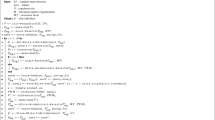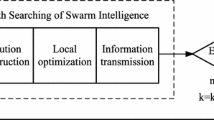Abstract
Bayesian networks (BNs) are widely used as one of the most effective models in bioinformatics, artificial intelligence, text analysis, medical diagnosis, etc. Learning the structure of BNs from data can be viewed as an optimization problem and is proved that this problem is NP-hard. Therefore, heuristic methods can be used as powerful tools to find high-quality networks. In this paper, an interesting approach which is based on Breeding Swarm has been used to learn BNs. Breeding Swarm is a hybrid GA/PSO which enable us to benefits the strengths of particle swarm optimization with genetic algorithms. In order to assess the proposed method, several real-world and benchmark applications are used. Results show that our method is a clear improvement on genetic algorithm and particle swarm optimization.













Similar content being viewed by others
References
Abramson B et al (1996) Hailfinder: a Bayesian system for forecasting severe weather. Int J Forecast 12:57–71
Ahmad FK, Deris S, Othman N (2012) The inference of breast cancer metastasis through gene regulatory networks. J Biomed Inform 45:350–362
Alonso-Barba JI, Puerta JM (2011) Structural learning of Bayesian networks using local algorithms based on the space of orderings. Soft Comput 15:1881–1895
BayesiaLab 6.0.2, Bayesia SAS, Laval, France. http://www.bayesialab.com
Beinlich IA (1989) The ALARM monitoring system: a case study with two probabilistic inference techniques for belief networks. Springer, Berlin
Binder J et al (1997) Adaptive probabilistic networks with hidden variables. Mach Learn 29:213–244
Cheng J, Bell DA and Liu W (1997) Learning belief networks from data: an information theory based approach. In: Proceedings of the sixth international conference on Information and knowledge management. ACM, pp 325–331
Chickering DM, Geiger D, Heckerman D (1995) Learning bayesian networks: search methods and experimental results. In: 5th international workshop on artificial intelligence and statistics, pp 112–128
Chickering DM (1996) Learning Bayesian networks is NP-complete. In: Fisher D, Lenz H-J (eds) Learning from data, vol 112. Springer, New York, pp 121–130
Chickering DM (2002) Optimal structure identification with greedy search. J Mach Learn Res 3:507–554
Colace F, De Santo M, Vento M (2010) A multiexpert approach for Bayesian network structural learning. In: 43rd Hawaii international conference on system sciences (HICSS), 2010 . IEEE pp 1–11
Colombo D, Maathuis MH (2014) Order-independent constraint-based causal structure learning. J Mach Learn Res 15:3741–3782
Cowell R (1998) Introduction to inference for Bayesian networks. In: Jordan MI (ed) Learning in graphical models, vol 89. Springer, Netherlands, pp 9–26
Cowie J, Oteniya L, Coles R (2007) Particle swarm optimisation for learning Bayesian networks. World Congress on Engineering, Newswood Limited/International Association of Engineers (IAENG), pp 71–76
Da You L et al (2001) Research on learning bayesian network structure based on genetic algorithms. J Comput Res Dev 8:916–922 (in Chinese)
Friedman N, Nachman I, Peér D (1999) Learning Bayesian network structure from massive datasets: the “sparse candidate” algorithm. In: Proceedings of the fifteenth conference on uncertainty in artificial intelligence. Morgan Kaufmann Publishers Inc., pp 206–215
Gámez JA, Mateo JL, Puerta JM (2011) Learning Bayesian networks by hill climbing: efficient methods based on progressive restriction of the neighborhood. Data Min Knowl Discov 22:106–148
Heckerman D, Geiger D, Chickering DM (1995) Learning Bayesian networks: the combination of knowledge and statistical data. Mach Learn 20:197–243
Hill SM et al (2012) Bayesian inference of signaling network topology in a cancer cell line. Bioinformatics 28:2804–2810
Jensen AL, Jensen FV (1996) MIDAS-an influence diagram for management of mildew in winter wheat. In: Proceedings of the twelfth international conference on uncertainty in artificial intelligence. Morgan Kaufmann Publishers Inc., pp 349–356
Ji J et al (2011) A hybrid method for learning Bayesian networks based on ant colony optimization. Appl Soft Comput 11:3373–3384
Ji J, Wei H, Liu C (2013) An artificial bee colony algorithm for learning Bayesian networks. Soft Comput 17:983–994
Khanteymoori AR, Menhaj MB, Homayounpour MM (2011) Structure learning in Bayesian networks using asexual reproduction optimization. ETRI J 33:39–49
Larrañaga P et al (2013) A review on evolutionary algorithms in Bayesian network learning and inference tasks. Inf Sci 233:109–125
Larrañaga P et al (1996) Structure learning of Bayesian networks by genetic algorithms: a performance analysis of control parameters. IEEE Trans Pattern Anal Mach Intell 18:912–926
Lauritzen SL, Spiegelhalter DJ (1988) Local computations with probabilities on graphical structures and their application to expert systems. J R Stat Soc B 50:157–224
Li Z et al (2011) Large-scale dynamic gene regulatory network inference combining differential equation models with local dynamic Bayesian network analysis. Bioinformatics 27:2686–2691
Mattew S, Terence S (2006) Breeding PSO: a GA/PSO Hybrid. Department of Computer Science, University of Idaho, Moscow
Munteanu P, Bendou M (2001) The EQ framework for learning equivalence classes of Bayesian networks. In: Proceedings ieee international conference on data mining, 2001. ICDM 2001. IEEE, pp 417–424
Murphy K, Mian S (1999) Modelling gene expression data using dynamic Bayesian networks. Technical report, Computer Science Division, University of California, Berkeley, CA
NorsysSoftwareCorp, 1990–2013. Netica. Version 5.12. http://www.norsys.com/
Robinson RW (1977) Counting unlabeled acyclic digraphs. In: Little CHC (eds) Combinatorial mathematics V. Lecture Notes in Mathematics, vol 622. Springer, Heidelberg, pp 28–43
Scheines R et al (1998) The TETRAD project: constraint based aids to causal model specification. Multivar Behav Res 33:65–117
Spiegelhalter DJ, Cowell RG (1992) Learning in probabilistic expert systems. Bayesian Stat 4:447–465
Spirtes P, Glymour CN, Scheines R (2000) Causation, prediction, and search. MIT press, Cambridge
Statnikov A (2010) Causal explorer: a matlab library of algorithms for causal discovery and variable selection for classification. Causation Predict Chall Chall Mach Learn 2:267
Tsamardinos I, Brown LE, Aliferis CF (2006) The max–min hill-climbing Bayesian network structure learning algorithm. Mach Learn 65:31–78
Wong ML, Lam W, Leung KS (1999) Using evolutionary programming and minimum description length principle for data mining of Bayesian networks. In: IEEE transactions on pattern analysis and machine intelligence, pp 174–178
Yang G, Lin Y, Bhattacharya P (2010) A driver fatigue recognition model based on information fusion and dynamic Bayesian network. Inf Sci 180:1942–1954
Ziegler V (2008) Approximation algorithms for restricted Bayesian network structures. Inf Process Lett 108:60–63
Zou M, Conzen SD (2005) A new dynamic Bayesian network (DBN) approach for identifying gene regulatory networks from time course microarray data. Bioinformatics 21:71–79
Author information
Authors and Affiliations
Corresponding author
Ethics declarations
Conflict of interest
The authors declare that they have no conflict of interest.
Additional information
Communicated by V. Loia.
Rights and permissions
About this article
Cite this article
Khanteymoori, A.R., Olyaee, MH., Abbaszadeh, O. et al. A novel method for Bayesian networks structure learning based on Breeding Swarm algorithm. Soft Comput 22, 3049–3060 (2018). https://doi.org/10.1007/s00500-017-2557-z
Published:
Issue Date:
DOI: https://doi.org/10.1007/s00500-017-2557-z




